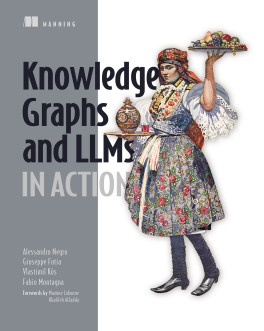pro $24.99 per month
- access to all Manning books, MEAPs, liveVideos, liveProjects, and audiobooks!
- choose one free eBook per month to keep
- exclusive 50% discount on all purchases
- renews monthly, pause or cancel renewal anytime
lite $19.99 per month
- access to all Manning books, including MEAPs!
team
5, 10 or 20 seats+ for your team - learn more

Look inside
Combine knowledge graphs with large language models to deliver powerful, reliable, and explainable AI solutions.
Knowledge graphs model relationships between the objects, events, situations, and concepts in your domain so you can readily identify important patterns in your own data and make better decisions. Paired up with large language models, they promise huge potential for working with structured and unstructured enterprise data, building recommendation systems, developing fraud detection mechanisms, delivering customer service chatbots, or more. This book provides tools and techniques for efficiently organizing data, modeling a knowledge graph, and incorporating KGs into the functioning of LLMs—and vice versa.
In Knowledge Graphs and LLMs in Action you will learn how to:
In Knowledge Graphs and LLMs in Action, you’ll discover the theory of knowledge graphs then put them into practice with LLMs to build working intelligence systems. You’ll learn to create KGs from first principles, go hands-on to develop advisor applications for real-world domains like healthcare and finance, build retrieval augmented generation for LLMs, and more.
Knowledge graphs model relationships between the objects, events, situations, and concepts in your domain so you can readily identify important patterns in your own data and make better decisions. Paired up with large language models, they promise huge potential for working with structured and unstructured enterprise data, building recommendation systems, developing fraud detection mechanisms, delivering customer service chatbots, or more. This book provides tools and techniques for efficiently organizing data, modeling a knowledge graph, and incorporating KGs into the functioning of LLMs—and vice versa.
In Knowledge Graphs and LLMs in Action you will learn how to:
- Model knowledge graphs with an iterative top-down approach based in business needs
- Create a knowledge graph starting from ontologies, taxonomies, and structured data
- Build knowledge graphs from unstructured data sources using LLMs
- Use machine learning algorithms to complete your graphs and derive insights from it
- Reason on the knowledge graph and build KG-powered RAG systems for LLMs
In Knowledge Graphs and LLMs in Action, you’ll discover the theory of knowledge graphs then put them into practice with LLMs to build working intelligence systems. You’ll learn to create KGs from first principles, go hands-on to develop advisor applications for real-world domains like healthcare and finance, build retrieval augmented generation for LLMs, and more.
about the technology
Using knowledge graphs with LLMs reduces hallucinations, enables explainable outputs, and supports better reasoning. By naturally encoding the relationships in your data, knowledge graphs help create AI systems that are more reliable and accurate, even for models that have limited domain knowledge.about the book
Knowledge Graphs and LLMs in Action shows you how to introduce knowledge graphs constructed from structured and unstructured sources into LLM-powered applications and RAG pipelines. Real-world case studies for domain-specific applications—from healthcare to financial crime detection—illustrate how this powerful pairing works in practice. You’ll especially appreciate the expert insights on knowledge representation and reasoning strategies.what's inside
- Design knowledge graphs for real-world needs
- Build KGs from structured and unstructured data
- Apply machine learning to enrich, complete, and analyze graphs
- Pair knowledge graphs with RAG systems
Comprehensive, pragmatic, definitive.
Builds understanding both at a theoretical and a practical level.
An excellent introduction to building KG and LLM-powered applications.
Comprehensive and well thought out! The authors hit it out of the park again.
choose your plan
team
monthly
annual
$49.99
$399.99
only $33.33 per month
- five seats for your team
- access to all Manning books, MEAPs, liveVideos, liveProjects, and audiobooks!
- choose another free product every time you renew
- choose twelve free products per year
- exclusive 50% discount on all purchases
- renews monthly, pause or cancel renewal anytime
- renews annually, pause or cancel renewal anytime
-
![]() Knowledge Graphs and LLMs in Action ebook for free
Knowledge Graphs and LLMs in Action ebook for free
choose your plan
team
monthly
annual
$49.99
$399.99
only $33.33 per month
- five seats for your team
- access to all Manning books, MEAPs, liveVideos, liveProjects, and audiobooks!
- choose another free product every time you renew
- choose twelve free products per year
- exclusive 50% discount on all purchases
- renews monthly, pause or cancel renewal anytime
- renews annually, pause or cancel renewal anytime
-
![]() Knowledge Graphs and LLMs in Action ebook for free
Knowledge Graphs and LLMs in Action ebook for free
choose your plan
team
monthly
annual
$49.99
$399.99
only $33.33 per month
- five seats for your team
- access to all Manning books, MEAPs, liveVideos, liveProjects, and audiobooks!
- choose another free product every time you renew
- choose twelve free products per year
- exclusive 50% discount on all purchases
- renews monthly, pause or cancel renewal anytime
- renews annually, pause or cancel renewal anytime
-
![]() Knowledge Graphs and LLMs in Action ebook for free
Knowledge Graphs and LLMs in Action ebook for free


















.jpg)
 Knowledge Graphs and LLMs in Action ebook for free
Knowledge Graphs and LLMs in Action ebook for free